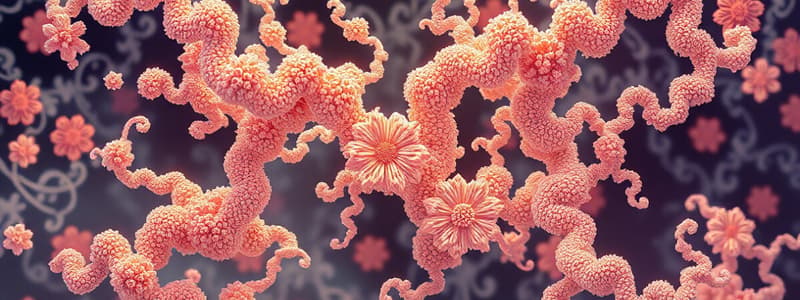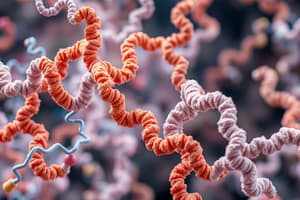Podcast
Questions and Answers
What determines the structure of proteins?
What determines the structure of proteins?
- The sequence of amino acids (correct)
- The temperature of the environment
- The pH level of the solution
- The presence of lipids
What is a key characteristic of α-amino acids?
What is a key characteristic of α-amino acids?
- Differentiated by different side-chains (R-group) (correct)
- They are all negatively charged
- They typically have 10 different types
- They contain multiple amino groups
Which statement correctly describes a zwitter ion?
Which statement correctly describes a zwitter ion?
- It is only positively charged
- It carries both a positive and negative charge (correct)
- It is a neutral molecule
- It is only negatively charged
What is one primary function of proteins?
What is one primary function of proteins?
How are proteins typically detected in laboratory settings?
How are proteins typically detected in laboratory settings?
What type of bonds primarily stabilize the structure of both the alpha helix and beta sheet?
What type of bonds primarily stabilize the structure of both the alpha helix and beta sheet?
Which amino acids are commonly found in U-turns of protein structures?
Which amino acids are commonly found in U-turns of protein structures?
What characterizes the quaternary structure of a protein?
What characterizes the quaternary structure of a protein?
Which structural feature is specifically described as a right-handed helix?
Which structural feature is specifically described as a right-handed helix?
What might low levels of hemoglobin indicate about a person's health?
What might low levels of hemoglobin indicate about a person's health?
What is the significance of L-amino acid enantiomers in proteins?
What is the significance of L-amino acid enantiomers in proteins?
Which amino acid is always the first in a polypeptide chain?
Which amino acid is always the first in a polypeptide chain?
What primarily determines the secondary structure of a protein?
What primarily determines the secondary structure of a protein?
Which structure of a protein is characterized by the linear sequence of amino acid residues?
Which structure of a protein is characterized by the linear sequence of amino acid residues?
What type of bonding does cysteine engage in to stabilize protein structure?
What type of bonding does cysteine engage in to stabilize protein structure?
Which element found in methionine and cysteine contributes to their unique properties?
Which element found in methionine and cysteine contributes to their unique properties?
In what way does the primary structure influence protein function?
In what way does the primary structure influence protein function?
What is the result of hydrogen bonding in secondary protein structure?
What is the result of hydrogen bonding in secondary protein structure?
What type of mutation leads to misfolding associated with sickle cell disease?
What type of mutation leads to misfolding associated with sickle cell disease?
Which condition is characterized by abnormal protein accumulation that forms extracellular deposits?
Which condition is characterized by abnormal protein accumulation that forms extracellular deposits?
What role does the C-peptide play during insulin synthesis?
What role does the C-peptide play during insulin synthesis?
Which of the following proteins is primarily associated with Alzheimer's disease?
Which of the following proteins is primarily associated with Alzheimer's disease?
What is a characteristic of prion proteins?
What is a characteristic of prion proteins?
What consequence results from premature stop codons in protein synthesis?
What consequence results from premature stop codons in protein synthesis?
In which cellular structure are insulin and its C-peptide stored?
In which cellular structure are insulin and its C-peptide stored?
Which ionic conditions in the trans Golgi network assist in protein aggregation?
Which ionic conditions in the trans Golgi network assist in protein aggregation?
What is the process called when abnormal PrPC converts normal PrPC into an abnormal form?
What is the process called when abnormal PrPC converts normal PrPC into an abnormal form?
Which disease in humans is associated with spongiform encephalopathies?
Which disease in humans is associated with spongiform encephalopathies?
What is the molecular weight of ubiquitin?
What is the molecular weight of ubiquitin?
Which of the following is NOT a function of proteins?
Which of the following is NOT a function of proteins?
Which of the following techniques is used for protein detection?
Which of the following techniques is used for protein detection?
What role does the proteasome play in the cell?
What role does the proteasome play in the cell?
Which of the following represents a structural protein?
Which of the following represents a structural protein?
What type of modification can proteins undergo after translation?
What type of modification can proteins undergo after translation?
Which type of proteins are involved in cell signaling?
Which type of proteins are involved in cell signaling?
What is one of the primary roles of glycosylation in proteins?
What is one of the primary roles of glycosylation in proteins?
Flashcards are hidden until you start studying
Study Notes
Proteins
- Complex biopolymers, whose structure is determined by the sequence of amino acids
Alpha Amino Acids
- Contain an asymmetric carbon
- Two stereoisomers exist called enantiomers or optical isomers
- Proteins in all life only contain L-amino acid enantiomers
- The surface of proteins is asymmetric, allowing for highly specific molecular recognition
- Play an important role in the formation of protein “secondary structure”
Methionine and Cysteine
- Both contain sulfur
- Methionine is always the first amino acid in a polypeptide chain
- The free sulfhydryl group of cysteine is highly reactive and is often used in enzyme active sites to attach various chemical groups to proteins
- Cysteine can form disulfide bonds
Primary Protein Structure
- The primary structure of a peptide or protein is the linear sequence of amino acid residues from the N- to the C-terminus.
Secondary Protein Structure
- Dependent on hydrogen bonding involving the peptide bonds
- Alpha Helix
- Beta Sheets
- U Turns
- The secondary structure of a protein is the folding pattern of the polypeptide chain.
Tertiary Structure
- Specifies the special arrangements of the secondary arrangement
Quaternary Protein Structure
- Several subunits held together by non-covalent bonds
Hemoglobin
- One example of a protein with quaternary structure
Sickle Cell Disease
- Abnormal primary structure can affect protein function
- Point mutations leading to misfolding
- Point mutations leading to trapping of protein in the ER
- Point mutations leading to premature stop codons
Insulin
- Proinsulin contains the amino acid sequence of insulin plus the 31-amino acid C (connecting) peptide
- In the Golgi apparatus, disulfide bonds are established, aided by C-peptide
- Sorting and packaging due to special surface proteins
- Insulin is stored in vesicles in zinc-bound crystals
- Proteases that cleave proinsulin are packaged within the secretory vesicle
Amyloidosis
- Accumulation of amyloid (proteins that have folded abnormally and aggregated together)
- Folded into beta sheets, they form extracellular deposits
Prions
- Proteinaceous infectious particles
- PrPC (Prion Protein) is a normal neuronal protein involved in cell adhesion, ion channel activity, and neuronal excitability
- In abnormal form, alpha helix changes to beta sheet
- Abnormal PrPC can convert normal PrPC into abnormal form
Histopathology
- Creutzfeldt-Jakob Disease (CJD)
- Gerstmann-Straussler-Scheinker Syndrome
- Kuru
- Scrapie in sheep
- Bovine Spongiform Encephalopathy (BSE) in cows
- Transmissible Mink Encephalopathy in mink
- Feline Spongiform Encephalopathy in cats
Protein Detection
- SDS Page gels – 1D and 2D
- Staining techniques
- Immunoblotting
- Mass spectrometry
- Crystallography
- Edman sequencing
Ubiquitination
- Ubiquitin is an 8.5kDa protein
- Marks proteins for degradation via the proteasome
- Binds to lysine, cysteine, threonine residues along the length of the target molecule or to the N-terminus of the protein
- Regulates major cellular processes such as cell division, immune responses, and embryonic development
Protein Breakdown
- Important way for cells to regulate expression of proteins
- The proteasome
Functions of Proteins
- Structural proteins
- Catalytic proteins – Enzymes
- Signaling Proteins
- Proteins involved in cell adhesion and recognition
- Membrane transport proteins
Functions of Proteins: Examples
- Extracellular Matrix Proteins (ECM) like collagen, Elastin, lamin and fibronectin
- Muscle proteins: actin and myosin
- Cytoskeletal proteins
- Proteins that participate in immunity (antibodies, complement system…)
- Transport proteins including Albumin (50% of plasma protein)
- Pro-and anti-coagulant proteins
- DNA binding proteins
Summary
- Proteins are organized in four different levels (primary to quaternary structure)
- There are several different detection levels for proteins
- Proteins can be post-translationally modified
- Proteins fulfill a wide array of functions
Studying That Suits You
Use AI to generate personalized quizzes and flashcards to suit your learning preferences.



